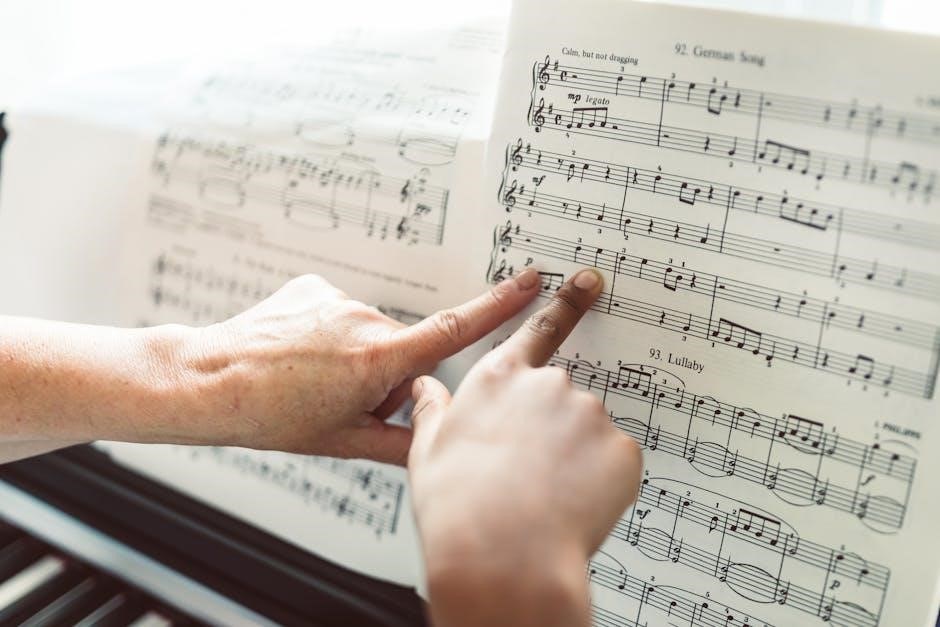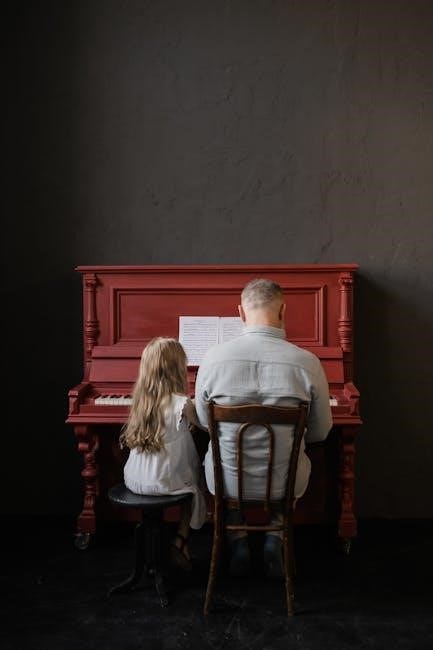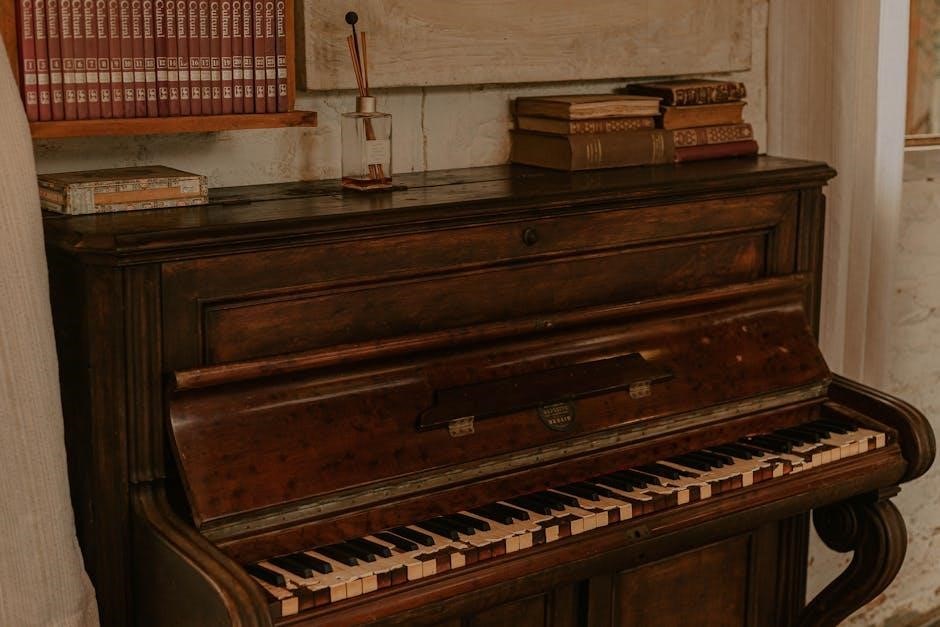Pachelbel’s Canon in D is a renowned Baroque composition, originally written for strings and continuo․ Its simple yet elegant chord progression and repetitive harmonic structure make it universally beloved․ The piece gained widespread popularity in the 20th century, often featured in weddings, films, and commercials․ As a result, its piano sheet music is highly sought after, with both free and premium arrangements readily available online․
1․1 Brief History and Popularity
Johann Pachelbel’s Canon in D, composed in the late 17th century, remained relatively obscure until its 20th-century revival․ Its Baroque elegance and iconic chord progression have made it a staple in classical music․ The piece’s popularity soared due to its widespread use in weddings, films, and commercials․ Today, it is one of the most recognized and beloved compositions globally, with its piano sheet music readily available in various arrangements․
1․2 Why It’s a Favorite for Piano Players
Pachelbel’s Canon in D is a favorite for piano players due to its timeless beauty and accessible structure․ Its iconic chord progression and repetitive harmonic pattern make it both soothing to play and a joy to master․ The piece’s adaptability to various arrangements, from simple to advanced, ensures it suits pianists of all skill levels․ Its emotional resonance and versatility in performance settings further enhance its appeal, making it a beloved choice for musicians worldwide․
Structure and Composition of the Canon in D
The Canon in D features a repeating chord progression (D, A, B minor, F# minor, G, D, G, A) with layered melodies, creating a flowing, harmonically rich structure․
2․1 Chord Progression and Harmonic Structure
The Canon in D is built on a repeating eight-chord progression: D, A, B minor, F# minor, G, D, G, A․ This harmonic pattern creates a sense of stability and progression, while its repetition allows for intricate melodic variations․ The chord sequence is simple yet timeless, contributing to the piece’s enduring appeal and adaptability across various arrangements․
2․2 Melodic Variations and Repetition
The Canon in D features a continuous bass line with repeating harmonic patterns, allowing for rich melodic variations․ Each iteration introduces new musical ideas while maintaining the foundational chord progression․ This structure creates a dialogue between voices, adding complexity and depth․ The repetition of the harmonic framework supports intricate variations, making it a masterpiece of Baroque counterpoint and a popular choice for pianists seeking both challenge and beauty․

Availability of Sheet Music
Pachelbel’s Canon in D is widely available as free PDF downloads for piano, with both simple and advanced arrangements․ Premium versions offer additional features like fingerings and transpositions, accessible through platforms like 8notes․com and Musicnotes․ This accessibility makes it easy for pianists of all levels to acquire and perform the piece․
3․1 Free PDF Downloads for Piano
Free PDF downloads of Pachelbel’s Canon in D for piano are readily available online․ Websites like 8notes․com and Musicnotes offer simplified versions, ideal for early learners․ These arrangements often include basic melodies and chord progressions, making them accessible to pianists of all skill levels․ Additionally, platforms like paultobey․com provide complimentary sheet music, ensuring easy access for those wanting to play this beloved piece․
3․2 Paid and Premium Arrangements
Premium arrangements of Pachelbel’s Canon in D offer advanced features for serious pianists․ Musicnotes and Hoffman Academy provide high-quality, transposable sheet music with fingerings and dynamics․ These detailed scores cater to intermediate and advanced players, enhancing performance accuracy․ Some editions include practice videos and MIDI files, aiding in mastering the piece․ Paid versions ensure a polished and professional playing experience, ideal for recitals or special events․

Learning to Play the Canon in D
Learning to play Pachelbel’s Canon in D is achievable with a structured approach and consistent practice, suitable for pianists of all skill levels․
4․1 Simplified Versions for Beginners
Simplified versions of Pachelbel’s Canon in D are available for early learners, offering easy-to-follow arrangements․ These versions often feature reduced complexity, slower tempos, and clear notation; Some include alphabotes, where notes are labeled with letters, aiding beginners in reading music․ Websites like 8notes․com and Musicnotes provide accessible PDF sheet music, ensuring newcomers can grasp the piece without overwhelming difficulty․ Guides and tutorials also accompany these versions, making learning enjoyable and straightforward․
4․2 Advanced Arrangements for Experienced Players
Advanced pianists can explore intricate arrangements of Pachelbel’s Canon in D, featuring complex fingerings and nuanced dynamics․ These versions often include challenging melodic variations and harmonic explorations․ Premium sheet music platforms like Musicnotes and Hoffman Academy offer transposable scores, allowing players to experiment with different keys․ Such arrangements cater to intermediate and advanced skill levels, providing depth and complexity for seasoned performers seeking to refine their technique and interpretation․
Popular Arrangements and Transpositions

Pachelbel’s Canon in D is widely transposed into various keys and arranged for multiple instruments, maintaining its timeless elegance․ These adaptations are readily available online, catering to diverse skill levels and preferences․
5․1 Solo Piano Arrangements
Pachelbel’s Canon in D is widely available as solo piano arrangements, ranging from simple versions for beginners to advanced adaptations․ These arrangements maintain the piece’s iconic chord progression and harmonic structure while offering pianists a chance to explore its beauty․ Many websites, such as 8notes․com and Musicnotes, provide free and premium PDF downloads, catering to all skill levels․ A structured approach and consistent practice make learning accessible for everyone, ensuring this timeless piece remains a staple in piano repertoire․
5․2 Arrangements for Other Instruments
Beyond piano, Pachelbel’s Canon in D is adapted for various instruments, showcasing its versatility․ Versions for trumpet quartets, cellos, and even solo violin are popular․ Arrangements for strings, woodwinds, and brass ensembles highlight the piece’s timeless appeal․ Sheet music for these adaptations is widely available, allowing musicians across genres to enjoy and perform this beloved Baroque classic, demonstrating its enduring influence and universal charm․
Historical Context and Baroque Music
Johann Pachelbel, a prominent Baroque composer, crafted the Canon in D during the late 17th century․ Its structure and harmonic simplicity reflect the era’s musical principles, showcasing Pachelbel’s mastery of counterpoint and chord progressions that defined Baroque composition․
6․1 Johann Pachelbel and His Contributions
Johann Pachelbel was a German Baroque composer and organist, renowned for his significant contributions to sacred and instrumental music․ His Canon in D, though not widely recognized in his lifetime, became a legendary piece in the 20th century․ Pachelbel’s works laid the groundwork for future composers, blending religious devotion with musical innovation, leaving a lasting impact on classical music heritage․
6․2 The Baroque Style in the Canon in D
Pachelbel’s Canon in D embodies the Baroque style through its intricate counterpoint and harmonic richness․ The piece features a repeating bass line, a common Baroque technique, with layered melodies creating a sense of grandeur․ Its structured, chordal progression reflects the period’s emphasis on form and musical convention, making it a timeless example of Baroque composition․
Performance Tips and Interpretations
Play with gentle dynamics and a steady tempo to enhance the piece’s serene beauty․ Use expressive techniques like slight rubato to add emotional depth without losing rhythmic clarity․
7․1 Tempo and Dynamics
Maintain a moderate tempo, typically between 90-100 BPM, to preserve the Canon’s calm and reflective nature․ Dynamics should be subtle, with soft arpeggios and gradual crescendos to highlight melodic variations․ Avoid abrupt changes to keep the piece flowing smoothly, ensuring a balanced and harmonious interpretation that aligns with its Baroque origins and modern performance practices․
7․2 Expressive Playing Techniques
Emphasize legato playing to maintain the Canon’s flowing nature․ Use dynamic contrasts, such as subtle crescendos and decrescendos, to enhance emotional depth․ Phrasing should be shaped naturally, with each melodic line starting softly and swelling gently․ Articulation can vary, with tenuto markings adding character․ Experiment with slight rubato for expressive touches, while keeping inner voices balanced to preserve harmonic clarity and richness․
Cultural Impact and Modern Usage
Pachelbel’s Canon in D is widely used in weddings, films, and commercials, showcasing its timeless appeal․ Its presence in diverse settings highlights its influence, making it a staple in both traditional and contemporary culture․
8․1 Use in Weddings and Ceremonies
Pachelbel’s Canon in D is a favorite at weddings and ceremonies due to its serene and joyous melody․ Its calming chord progression creates a perfect backdrop for processions or receptions․ Available as solo piano or instrumental arrangements, it offers versatility for couples seeking timeless elegance․ Free and premium sheet music options make it accessible for performers of all levels to incorporate this beloved piece into their celebrations․
8․2 Appearances in Media and Pop Culture
Pachelbel’s Canon in D frequently appears in films, TV shows, and commercials, adding emotional depth to scenes․ Its soothing melody has been featured in movies like Ordinary People and The Wedding Singer․ It also inspired countless pop culture parodies and covers, showcasing its versatility․ The piece’s familiarity makes it a go-to choice for creating nostalgic or romantic atmospheres in media, further cementing its cultural significance․

Resources for Piano Players
Piano players can access Pachelbel’s Canon in D sheet music through websites like 8notes․com and Musicnotes, offering both free and premium arrangements․ Video tutorials and guides are also available online to aid in learning and mastering the piece;
9․1 Recommended Websites for Sheet Music
Popular websites like 8notes․com, Musicnotes, and Hoffman Academy offer high-quality sheet music for Pachelbel’s Canon in D․ These platforms provide both free and premium arrangements, catering to pianists of all skill levels․ They often include features like MIDI playback, transpose options, and fingerings, making it easier for players to learn and perform the piece effectively․
9․2 Tutorials and Video Guides
YouTube and platforms like Hoffman Academy offer tutorials and video guides for Pachelbel’s Canon in D․ These resources provide step-by-step lessons, breaking down the piece for pianists of all levels․ Many sheet music downloads include practice videos or MIDI files, enabling learners to follow along visually and aurally․ Such guides are invaluable for mastering the composition’s harmonic and melodic nuances efficiently․
Variations and Simplifications
Pachelbel’s Canon in D is available in various simplified versions, catering to early learners and experienced players․ Easy arrangements in C major and creative remixes maintain the original charm while offering accessibility for diverse skill levels․
10․1 Easy Versions for Early Learners
Pachelbel’s Canon in D is available in simplified versions tailored for early learners, often featuring alphabotes to aid note recognition․ These adaptations use simpler keys, such as C major, to ease the learning process․ They provide a foundational understanding of the piece, allowing beginners to grasp its structure and melody without the complexity of advanced arrangements․
10․2 Creative Rearrangements and Remixes
Pachelbel’s Canon in D has inspired numerous creative rearrangements, from jazz and contemporary piano interpretations to electronic and orchestral versions․ These remixes often blend the original harmonic structure with modern styles, offering fresh perspectives․ They cater to diverse skill levels and instruments, making the piece adaptable for various performances while maintaining its timeless appeal and versatility across musical genres and formats․

Challenges for Pianists
Mastering Pachelbel’s Canon in D requires precision in timing and finger dexterity due to its repetitive yet intricate harmonic structure and melodic variations, posing technical challenges for pianists․
11․1 Technical Difficulties
Pianists face challenges with the repetitive chord progression and intricate fingerwork in Pachelbel’s Canon in D․ Maintaining precise timing and rhythmic accuracy is crucial, as the piece relies heavily on a steady tempo․ The harmonic structure, while simple, requires careful hand coordination to avoid muddling the melody․ Additionally, the repetitive nature of the composition can lead to fatigue, making consistent practice essential to master the technique seamlessly․
11․2 Maintaining Rhythmic Accuracy
Maintaining rhythmic accuracy in Pachelbel’s Canon in D is essential due to its repetitive chord progression and Baroque-style structure․ The steady tempo requires precise timing to preserve the piece’s flow․ Slight deviations can disrupt the harmonic balance․ Using a metronome and consistent practice help pianists master the timing․ The simplicity of the composition demands attention to rhythmic detail to ensure a polished performance․

Modern Interpretations and Innovations
Pachelbel’s Canon in D has inspired modern artists to reimagine the piece in various genres, such as jazz, electronic, and orchestral arrangements, breathing fresh life into the classic composition․
12․1 Jazz and Contemporary Arrangements
Jazz and contemporary interpretations of Pachelbel’s Canon in D offer fresh perspectives, blending improvisation and syncopation with the timeless harmonic structure․ These arrangements often feature dynamic rhythms and modern chord voicings, appealing to a diverse audience․ Musicians and arrangers experiment with genres like swing, blues, and even electronic fusion, creating vibrant renditions that honor the original while exploring new sonic landscapes․
Piano sheet music for these modern versions is widely available, allowing artists to adapt the piece to their unique style․ This evolution ensures the Canon remains relevant in today’s musical landscape, bridging centuries of tradition with contemporary creativity․
12․2 Electronic and Orchestral Versions
Electronic and orchestral interpretations of Pachelbel’s Canon in D offer grand, layered reimaginations․ Orchestral arrangements often feature full ensembles, emphasizing the piece’s harmonic richness․ Electronic versions incorporate synthesizers and modern production techniques, creating a futuristic ambiance․ Both styles maintain the original’s iconic chord progression while introducing expansive textures, making them popular in film scores, ambient playlists, and live performances; These adaptations showcase the timeless versatility of Pachelbel’s masterpiece․
Pachelbel’s Canon in D remains a timeless, versatile masterpiece, cherished for its soothing harmony and adaptability․ Its enduring appeal ensures its continued relevance in modern music and culture․
13․1 The Enduring Appeal of Pachelbel’s Canon
Pachelbel’s Canon in D captivates audiences with its timeless elegance and emotional depth․ Its simple yet powerful chord progression and melodic variations create a soothing yet uplifting experience․ The piece’s versatility allows it to resonate in various settings, from weddings to classical performances, making it a beloved choice for musicians and listeners alike․ Its enduring popularity is a testament to its universal appeal and the emotional connection it fosters․
13․2 Final Thoughts on Learning and Performing
Learning and performing Pachelbel’s Canon in D is a rewarding experience, offering pianists a chance to master a timeless classic․ With accessible sheet music available, from simplified versions for beginners to advanced arrangements, musicians of all levels can enjoy this piece; Consistent practice and dedication will help pianists overcome challenges, ensuring a polished and emotive performance that resonates with audiences worldwide․